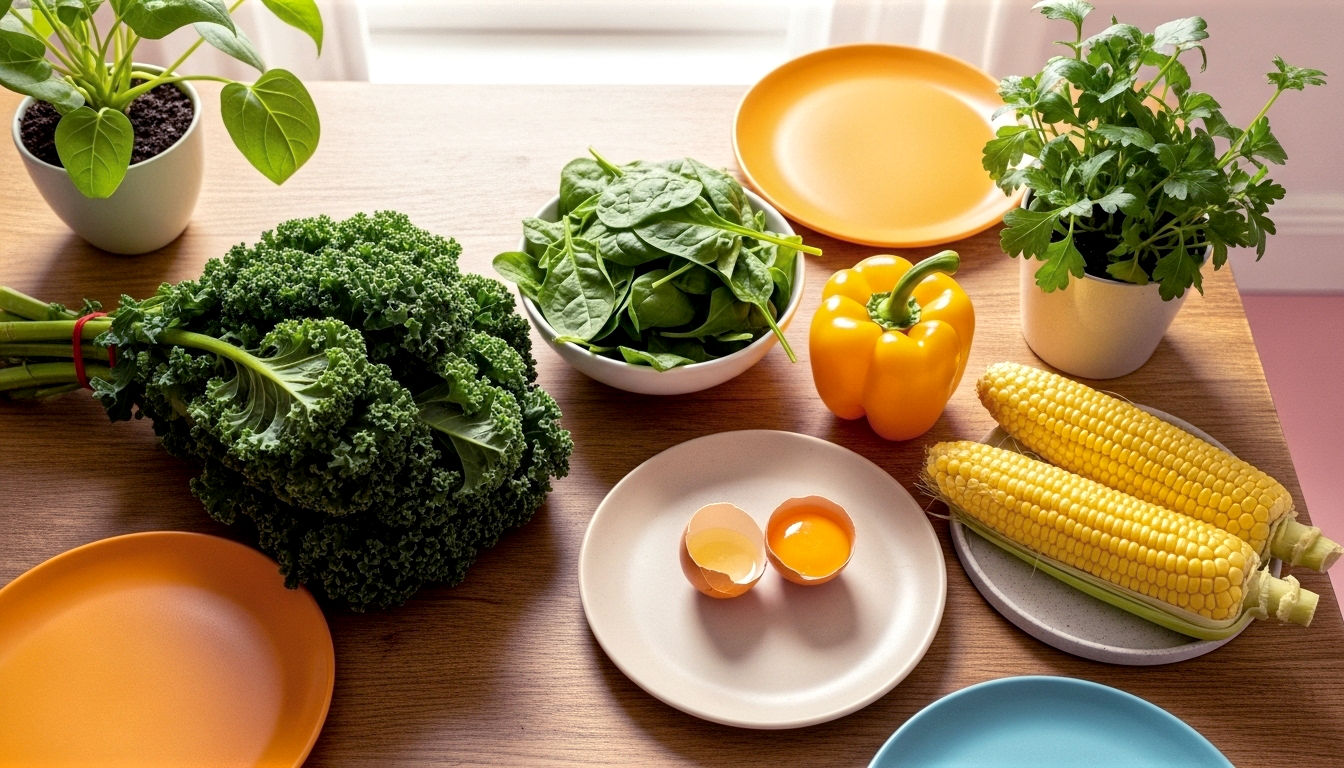The Guide to Lutein and Zeaxanthin: Your Eyes’ Best Mates
The complete UK guide to lutein and zeaxanthin. Learn what these powerful antioxidants are, why they’re crucial for eye health, and the best foods to eat.

This post may contain affiliate links. If you make a purchase through these links, we may earn a commission at no additional cost to you.
Ever wondered what gives a bright yellow corn on the cob its cheerful colour, or what makes leafy green veg like spinach and kale so good for you? Part of the answer lies with two little-known heroes of the nutrition world: lutein and zeaxanthin.
You might not have heard of them, but these two powerhouses are working behind the scenes to keep your eyes healthy. Think of them as your eyes’ personal bodyguards, protecting them from the wear and tear of daily life. In a world where we spend hours staring at screens, from our phones and laptops to the telly, understanding how to look after our peepers has never been more important.
This guide is your ultimate resource for everything lutein and zeaxanthin. We’ll break down exactly what they are, why they’re so brilliant for your eyes (and the rest of your body), and where you can find them. Forget complicated science talk – we’ll explain it all in a way that makes sense, like chatting with a friend down the pub. So, grab a cuppa, get comfy, and let’s dive into the fascinating world of these amazing antioxidants.
What Exactly Are Lutein and Zeaxanthin?
Right, let’s get down to the basics. What are these things with the funny-sounding names?
In simple terms, lutein (pronounced loo-teen) and zeaxanthin (pronounced zee-uh-zan-thin) are types of pigments found in plants. They’re part of a big family of colourful compounds called carotenoids.
You’re already familiar with another carotenoid: beta-carotene. It’s the stuff that gives carrots their bright orange colour and is famous for helping you see in the dark (or so your parents told you!). Lutein and zeaxanthin are the yellow-orange pigments. You’ll find them in all sorts of colourful fruits and vegetables, like bell peppers, sweetcorn, and even the yolk of an egg.
But here’s the clever bit. While they’re found in lots of yellow and orange foods, they’re also hiding in dark green leafy vegetables like spinach, kale, and broccoli. The green colour in these plants, which comes from chlorophyll, is so strong that it masks the yellow-orange pigments of lutein and zeaxanthin. But trust us, they’re in there, working their magic.
The Body’s Own Sunglasses
So, what makes these two carotenoids so special? Well, unlike many other nutrients, lutein and zeaxanthin are drawn to one specific part of your body: your eyes.
They build up in a tiny but incredibly important area at the back of your eye called the macula. The macula is part of the retina and is responsible for your sharp, detailed, central vision – the kind you need for reading a book, recognising faces, or watching the footie.
Because they collect here in high concentrations, lutein and zeaxanthin are often called macular pigments. Once they’re settled in your macula, they act like a pair of internal sunglasses. They help to filter out harmful, high-energy blue light from the sun and from the screens we look at every day.
Think of it like this: spending a day at the beach without your sunnies would leave your eyes feeling strained and sore. Lutein and zeaxanthin do a similar job, but from the inside out, protecting the delicate cells in your eyes 24/7.
Antioxidants: The Body’s Rust-Proofing Crew
Beyond being your eyes’ built-in sunblock, lutein and zeaxanthin are also powerful antioxidants.
To understand what that means, we need to talk about something called oxidative stress. It sounds complicated, but the idea is quite simple. All day, every day, your body is busy turning food into energy. This process, along with things like exposure to sunlight and pollution, creates unstable little molecules called free radicals.
Free radicals are a bit like tiny troublemakers bouncing around inside your body. They can damage your cells, proteins, and even your DNA. This damage is what we call oxidative stress. Over time, it can contribute to ageing and a whole host of health problems. It’s a bit like how metal rusts when it’s exposed to oxygen and water – it’s a form of natural decay.
This is where antioxidants come in. They are like the body’s rust-proofing crew. They travel around your system, neutralising these free radicals before they can do any harm. By mopping up these damaging molecules, antioxidants help protect your cells and keep your body running smoothly.
Lutein and zeaxanthin are particularly good at this job in the eyes. The eye uses a lot of oxygen, which makes it a hotspot for free radical activity. By fighting oxidative stress in the retina, these two antioxidants help keep your vision sharp and healthy for the long run.
Why Are Lutein and Zeaxanthin So Crucial for Eye Health?
We’ve touched on their role as internal sunglasses and antioxidants, but let’s look a bit closer at the specific ways lutein and zeaxanthin protect your precious eyesight. Their benefits are most well-known for two common age-related eye conditions: Age-Related Macular Degeneration (AMD) and cataracts.
Fighting Age-Related Macular Degeneration (AMD)
Age-Related Macular Degeneration, or AMD, is the leading cause of sight loss in the UK for people over 50. It affects the macula, that tiny spot at the back of the eye we mentioned earlier, which controls our central vision.
When the macula becomes damaged, your central vision gets blurry. This can make everyday tasks like reading, driving, or even seeing a friendly face incredibly difficult. While your peripheral (side) vision usually stays fine, losing that sharp, straight-ahead sight can have a massive impact on your quality of life.
So, how do lutein and zeaxanthin help?
- Filtering Blue Light: The macula is particularly vulnerable to damage from high-energy blue and ultraviolet (UV) light. Lutein and zeaxanthin act as a natural filter, absorbing this harmful light before it can reach and damage the sensitive photoreceptor cells in the macula. It’s like having a protective shield right where you need it most. The more of these pigments you have in your macula, the thicker the shield and the better the protection.
- Reducing Oxidative Stress: As we know, the eye is a busy place with lots of oxygen, making it prone to oxidative stress. The powerful antioxidant properties of lutein and zeaxanthin help to neutralise the free radicals that can damage the cells of the macula, slowing down the degenerative processes that lead to AMD.
Major scientific studies, like the landmark Age-Related Eye Disease Studies (AREDS and AREDS2), have provided strong evidence for this. The AREDS2 study, in particular, found that a specific supplement formula containing lutein and zeaxanthin could significantly reduce the risk of advanced AMD for people who were already at high risk. This was a huge breakthrough and is why eye doctors now regularly recommend these nutrients to patients with early signs of the condition.
Preventing Cataracts
Another common eye problem that tends to creep up with age is cataracts. A cataract is when the lens of your eye, which is normally crystal clear, becomes cloudy and opaque. It’s a bit like trying to look through a foggy window. Everything becomes blurry, colours can look faded, and you might find bright lights and glare really uncomfortable.
Cataracts form when the proteins in your lens start to clump together. One of the main culprits behind this clumping process is – you guessed it – oxidative stress.
Here again, lutein and zeaxanthin come to the rescue. As powerful antioxidants, they are found in the lens of the eye as well as the macula. They help to protect the lens from the damage caused by free radicals, which in turn can help slow down the formation and progression of cataracts.
Several large-scale studies have shown that people with a higher intake of lutein and zeaxanthin from their diet have a lower risk of developing cataracts. While they might not prevent them altogether, getting enough of these nutrients is certainly a smart move for keeping your lenses clearer for longer.
Beyond AMD and Cataracts: Other Eye Benefits
The good work of lutein and zeaxanthin doesn’t stop there. Research suggests they may have other benefits for our eyes too.
- Improving Visual Performance: Even in people with healthy eyes, having a good level of macular pigment can improve visual function. This might mean better contrast sensitivity (the ability to see objects against a similar background), reduced glare, and faster recovery from bright light exposure (like after being dazzled by headlights at night). For athletes, this could mean seeing a ball more clearly against the sky. For the rest of us, it might just make driving at night a bit more comfortable.
- Helping with Diabetic Retinopathy: For people with diabetes, there is a risk of developing an eye condition called diabetic retinopathy. This is where high blood sugar levels damage the blood vessels in the retina. Early research suggests that the antioxidant and anti-inflammatory properties of lutein and zeaxanthin might help to protect the retina from this type of damage.
- Reducing Eye Fatigue and Strain: In our screen-obsessed world, many of us suffer from digital eye strain. Symptoms include tired, dry, or itchy eyes, headaches, and blurred vision. Because lutein and zeaxanthin filter blue light – the type that’s emitted in large amounts by our phones, tablets, and computers – they may help to reduce this strain and keep our eyes feeling more comfortable.
Where Can You Find Lutein and Zeaxanthin? The Best Food Sources
The great news is that your body knows exactly what to do with lutein and zeaxanthin when you eat them. The not-so-great news is that your body can’t make them on its own. This means you have to get them entirely from your diet.
Luckily, they’re found in a wide variety of delicious and healthy foods. Topping up your levels is easier than you might think.
Go for Green: The Leafy Superstars
The absolute best sources of lutein and zeaxanthin are dark green leafy vegetables. This is where you’ll get the most bang for your buck. The top players are:
- Kale: The undisputed king of lutein. A single serving can give you well over your daily needs. Whether you steam it, add it to a stir-fry, or even bake it into crispy kale chips, it’s a brilliant choice.
- Spinach: Another fantastic source. Popeye was definitely onto something. Enjoy it raw in salads, wilted into pasta dishes, or blended into a green smoothie.
- Swiss Chard: Similar to spinach, it’s packed with these eye-healthy nutrients.
- Collard Greens: A staple in Southern US cooking, but becoming more popular here in the UK.
- Watercress: That peppery kick comes with a healthy dose of lutein. Perfect for salads and sandwiches.
The Colourful Veggies and Fruits
Don’t fancy leafy greens? No problem. You can also find good amounts of lutein and zeaxanthin in a rainbow of other fruits and vegetables. Look for yellow and orange produce:
- Sweetcorn: A fantastic and kid-friendly source.
- Bell Peppers: Especially the yellow and orange varieties.
- Broccoli: A true superfood, it contains a good amount alongside many other vitamins.
- Peas: A humble but mighty source.
- Pumpkin and Squash: Think butternut squash or other winter squashes.
- Persimmons, Papaya, and Oranges: These fruits also contribute to your intake.
Don’t Forget the Eggs!
Here’s an interesting one: egg yolks. While they don’t contain as much lutein and zeaxanthin as kale or spinach, the form they come in is highly bioavailable.
This means your body can absorb and use it very easily. Why? Because egg yolks also contain fats, and lutein and zeaxanthin are fat-soluble nutrients. This means they need a bit of fat to be absorbed properly by your gut. So, a poached egg on wholemeal toast is not only a delicious breakfast but also a brilliant way to get some eye-boosting nutrients.
A Quick Tip for Better Absorption
To get the most out of the lutein and zeaxanthin in your veggies, it’s a good idea to eat them with a small amount of healthy fat. This could be as simple as drizzling some olive oil on your salad, adding a few slices of avocado, or tossing your steamed greens in a little butter. This simple trick helps your body to absorb these fat-soluble carotenoids much more effectively.
Here’s a quick-reference table to help you out:
| Food (Cooked, 1 cup/approx. 150g) | Estimated Lutein & Zeaxanthin (mg) |
|---|---|
| Kale | 23.7 mg |
| Spinach | 20.4 mg |
| Swiss Chard | 19.3 mg |
| Peas | 4.1 mg |
| Broccoli | 1.6 mg |
| Sweetcorn | 1.4 mg |
| Egg (1 large) | 0.3 mg |
Note: These values are approximate and can vary depending on the specific product and preparation method.
What About Supplements? Should You Be Taking Them?
With all the buzz around lutein and zeaxanthin, it’s no surprise that you can now find them in supplement form, often combined with other vitamins and minerals in an “eye health” formula. This leads to a common question: do you need to take a supplement?
For most healthy people, the answer is probably no. If you eat a balanced diet that’s rich in fruits and vegetables, especially the green leafy ones, you should be able to get enough lutein and zeaxanthin from your food. The general advice from health bodies like the NHS is always to aim for a “food first” approach. Whole foods provide a complex package of nutrients, fibre, and other beneficial compounds that you just can’t get from a pill.
However, there are certain situations where a supplement might be recommended by a healthcare professional, such as an optometrist or a GP.
When Supplements Might Be a Good Idea
The main group of people who may benefit from supplements are those at high risk of developing advanced AMD. This includes individuals who already have intermediate AMD in one or both eyes.
The AREDS2 study, which we mentioned earlier, showed that a specific daily supplement formula could be beneficial for this group. The formula used in that study contained:
- 10 mg of lutein
- 2 mg of zeaxanthin
- Vitamin C (500 mg)
- Vitamin E (400 IU)
- Zinc (80 mg, though a lower dose of 25mg is now often recommended)
- Copper (2 mg, to prevent a zinc-induced copper deficiency)
It’s really important to note that this formula was shown to help people who already had signs of AMD. For people with healthy eyes, the evidence that these high-dose supplements can prevent AMD from starting in the first place is less clear.
Supplements might also be considered for people who have very poor diets and struggle to eat enough fruit and veg. However, the better long-term solution is always to try to improve the diet itself.
Always Chat with a Professional First
The bottom line is this: don’t start taking high-dose eye health supplements without talking to an eye care professional or your doctor first.
They can assess your individual risk for eye disease, look at the health of your eyes, and give you personalised advice. Self-prescribing isn’t a good idea, as high doses of certain vitamins can be harmful or interact with other medications you might be taking.
Lutein and Zeaxanthin for Brain Health: A Surprising Connection
While the spotlight is usually on eye health, exciting new research is revealing that lutein and zeaxanthin might be good for our brains too. This makes sense when you think about it – the eye is directly connected to the brain via the optic nerve. What’s good for one is often good for the other.
Just as they accumulate in the retina, lutein is the main carotenoid found in the brain. Studies are starting to show a link between higher levels of lutein in the brain and better cognitive function, especially in older adults.
How Might They Help the Brain?
Researchers believe lutein and zeaxanthin may support brain health in several ways:
- Antioxidant Protection: The brain is another organ that uses a lot of oxygen and is highly susceptible to oxidative stress. The antioxidant powers of lutein can help protect brain cells from this damage.
- Anti-Inflammatory Effects: Chronic inflammation is thought to play a role in cognitive decline. Lutein has anti-inflammatory properties that could help to dampen this process in the brain.
- Improving Neural Efficiency: Some studies suggest that lutein might help brain cells to communicate with each other more efficiently. This could translate to faster processing speed and better memory.
A study from the University of Georgia in the US found that older adults who took a lutein and zeaxanthin supplement for a year showed improvements in several measures of cognitive function, including memory and verbal fluency, compared to those who took a placebo.
This is a really promising area of research. While it’s still early days, it’s another great reason to make sure you’re getting plenty of lutein-rich foods in your diet. It’s not just about sharp vision, but potentially about keeping your mind sharp too.
What About Skin Health?
The benefits don’t stop at the eyes and brain. Lutein and zeaxanthin are also found in your skin. Here, they offer another layer of protection, once again related to their ability to deal with light and oxidative stress.
Their main role in the skin is to help protect it from damage caused by the sun’s UV radiation. Just as they filter blue light in the eye, they can help to absorb and neutralise the damaging effects of UV rays on the skin.
This doesn’t mean you can skip the sunscreen! Eating kale won’t stop you from getting sunburnt. However, a diet rich in these antioxidants may provide a small amount of extra internal protection against the long-term ageing effects of sun exposure, like wrinkles and fine lines. Think of it as an extra little helper working alongside your sun cream.
Frequently Asked Questions (FAQs)
Let’s tackle some of the common questions people have about lutein and zeaxanthin.
How much lutein and zeaxanthin do I need per day?
There isn’t an official UK Recommended Daily Allowance (RDA) for lutein and zeaxanthin, as they aren’t considered essential vitamins. However, based on research, most experts suggest that an intake of around 10 mg of lutein and 2 mg of zeaxanthin per day is beneficial for eye health.
To put that into perspective, a 100g serving of cooked spinach provides about 12 mg of lutein and zeaxanthin combined, so it’s very achievable through diet alone.
Does cooking destroy lutein and zeaxanthin?
This is a great question. Cooking can actually increase the bioavailability of lutein and zeaxanthin. Lightly cooking vegetables like spinach and kale helps to break down their tough cell walls, making it easier for your body to absorb the nutrients inside.
So, lightly steaming, sautéing, or wilting your greens is a fantastic idea. Just be careful not to overcook them, as this can start to destroy some of the other more sensitive vitamins, like vitamin C.
Are there any side effects or risks?
Lutein and zeaxanthin from food sources are considered completely safe. You can’t “overdose” on spinach!
With supplements, it’s a different story. While they are generally safe for most people when taken at the recommended doses, very high intakes over a long period could potentially cause a harmless condition called carotenemia. This is where your skin takes on a slight yellowish tinge. It’s not dangerous and goes away once you reduce your intake.
As always, the key is to speak with a healthcare professional before starting any new high-dose supplement.
Can children benefit from lutein and zeaxanthin?
Yes, absolutely. Good nutrition for eye and brain development starts from a young age. While children aren’t at risk of AMD, lutein and zeaxanthin are still important for protecting their eyes from sunlight and screen time. Encouraging them to eat a colourful variety of fruits and vegetables is one of the best things you can do for their long-term health.
The Takeaway: A Simple Recipe for Healthier Eyes
So, after all that, what’s the main message? It’s actually very simple.
Lutein and zeaxanthin are incredible nutrients that act as your body’s own internal defence system, particularly for your eyes. They shield your delicate macula from harmful blue light and fight the oxidative stress that contributes to common age-related eye conditions like AMD and cataracts.
You don’t need to get bogged down in complex science or expensive supplements. For most of us, the path to healthier eyes is paved with delicious, colourful food.
The best thing you can do today is to start packing your plate with dark green leafy vegetables like kale and spinach, and a vibrant mix of other veg like sweetcorn, peas, and peppers. Don’t forget to add a source of healthy fat, like a splash of olive oil, to help your body absorb all that goodness.
Looking after your eyes is a lifelong journey. By making friends with lutein and zeaxanthin, you’re taking a simple, powerful, and tasty step towards protecting your sight for many years to come.
Further Reading
For those who wish to delve deeper into the science and recommendations around eye health, here are some highly respected resources:
- Macular Society (UK): The leading charity for people with macular disease in the UK. They provide excellent, trustworthy information on AMD and the role of nutrition. https://www.macularsociety.org/
- Royal National Institute of Blind People (RNIB): A fantastic resource for all aspects of eye health and sight loss. https://www.rnib.org.uk/
- The College of Optometrists (UK): The professional body for optometrists in the UK, offering patient-friendly information on eye conditions. https://www.college-optometrists.org/
- National Eye Institute (NEI) (US): The home of the landmark AREDS/AREDS2 studies, with in-depth information on the research. https://www.nei.nih.gov/
- British Nutrition Foundation: For general, evidence-based advice on diet and health in the UK. https://www.nutrition.org.uk/






